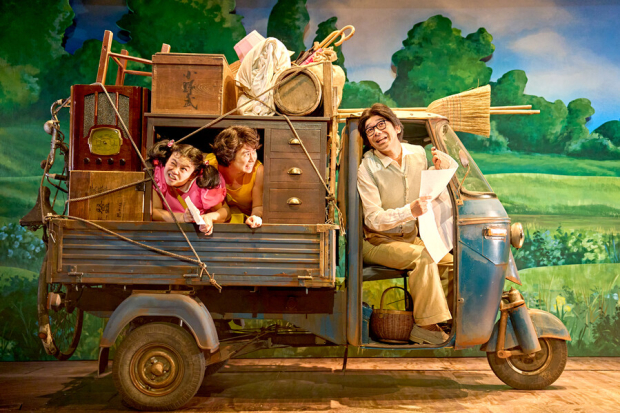”My Neighbour Totoro” review – colossal spirits awe in sumptuous Studio Ghibli staging

© RSC/ Nippon TV, photo by Manuel Harlan
For not only is this tale of two girls who encounter a mythical creature in the woods a beloved staple of many childhoods, it’s also, frankly, completely bonkers. That aforementioned creature, the titular Totoro, is a giant, hairy, shouting sort-of-rabbit who flies around in a massive ten-legged cat-bus. Hayao Miyazaki’s masterpiece, set in postwar Japan, is a fever dream of disparate ideas and ancient mythology.
Many years in development, this theatrical incarnation makes innovative use of puppetry, designed by Basil Twist and the Jim Henson Company, to bring its cast of magical spirits and more earthly creatures to life. The staging is genuine jaw-on-the-floor stuff, with a team of visible puppeteers (several gags are made about this) flitting around to manifest everything from tiny, fluffy soot sprites to the proscenium-filling main character, whose first appearance is greeted by an ovation.

© RSC with Nippon TV, photo by Manuel Harlan
Director Phelim McDermott throws all of his characteristic inventiveness at Tom Morton-Smith’s faithful adaptation, and the result feels like a loving homage to the film in both its embrace of visual quirkiness and wilful ignorance of narrative convention. As in The Snowman, which I’ve often considered Totoro‘s close relation, the story itself is pretty thin stuff. It’s the incredible – and incredulous – main encounter, and the mix of comfort and wonder it brings to the children, that generates the magic.
Morton-Smith has added a bit of extra padding, most notably by expanding the character of the sisters’ awkward young neighbour Kanta (Nino Furuhata). But the sparseness of the dialogue on screen is largely echoed on stage, where the pacing can accurately be described as glacial. This is a world where detail is everything, and planting acorns and waiting for them to grow counts as a dramatic high point.
The Barbican’s expansive main stage is filled to the gunnels by Tom Pye’s highly dynamic set, which slides in and out to form the Kusakabe family home one minute and Totoro’s woodland enclosure the next. At various stages trees arch over the stage and a huge moon illuminates the back wall. It evokes a landscape that is at once rustic and strange, a place where labourers work the fields and spirits control the elements. And it’s all sumptuously lit by Jessica Hung Han Yun; when the cat-bus arrives it’s like the sun itself has descended onto the stage.

© RSC and Nippon TV, photo by Manuel Harlan
It all makes for an incredible spectacle, especially for children. I took my eight-year-old daughter, a Totoro aficionado, and she was literally jumping in her seat for much of it, whispering excited exclamations (“my seat’s shaking,” she said as Totoro emitted his deep, visceral roars). But for all its grandeur there are simpler charms as well; see a gag where a bus enters, and the driver castigates the puppeteer on whose shoulders he is sitting for walking too fast.
There are some enjoyable performances too, particularly from the central family. Ami Okumura Jones and Mei Mac exhibit all the playfulness, squabbling and care embodied by sisters Satsuki and Mei, while their father Tatsuo is a fittingly lovable Dai Tabuchi. In one particularly moving moment he is forced away from his wife Yasuko’s (Haruka Abe) hospital bed by the puppeteers, as if unable to move himself. The emotion is heightened by Joe Hisaishi’s wonderful soundtrack, played by an orchestra arranged on a platform across the back of the stage. The songs, especially that peach of a title number, are sung with delicate beauty by soloist Ai Ninomiya.
The ending can feel anticlimactic, and I wasn’t convinced by the additional dialogue that seemed to be trying to compensate for its ambiguity and tie things up a little too neatly. But the elongated curtain call is among the most joyous and creative finales you will see, and leaves you floating out afterwards feeling like you’ve just spent two and a half hours in a kind of all-over spa for the soul. Right now we could all use a big hug from Totoro, and this is about as close as you can get.













